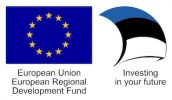Semiotics of conflict
Spring School, 5-7 June 2019, Estonia
The upcoming Spring School explores the dynamic nature of conflicts through lectures and workshops providing insight into diverse cultural contexts. The school encourages interdisciplinary discussions regarding cultural, social, and environmental conflicts involving concrete case studies, practical applications, and universal theories striving towards a more profound understanding of the semiotic nature of conflicts.
SPEakers
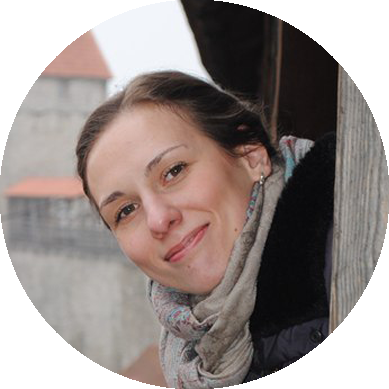
Anastasiya Astapova
Anastasiya Astapova is a research fellow at the Department of Estonian and Comparative Folklore, University of Tartu and an elected member of the Young Estonian Academy of Sciences. She has recently defended her PhDs on student humor (Academy of Sciences, Russia 2016) and Belarusian political folklore and nationalism (University of Tartu, Estonia 2015) and visited Uppsala University (Institute for Russian and Eurasian Studies) as a postdoc research fellow (2017-2018). Her recent interests have shifted to the study of migration and integration in Estonia as well as to the study of conspiracy theories.

Jonathan Luke Austin
Jonathan Luke Austin is a political sociologist and Lead Researcher for the Violence Prevention (VIPRE) Initiative at the Centre on Conflict, Development and Peacebuilding of the Graduate Institute, Geneva. Austin’s research is focused around the ontologies of political violence, the relationships between technology, ergonomic design and world politics, the political status of aesthetics, and the contemporary state of scientific critique. Alongside these foci, Austin possesses a decade of research and field experience in the Middle East (Syria, Lebanon, Iraq, Palestine, Jordan, Turkey) and regularly consults for NGOs and the media.
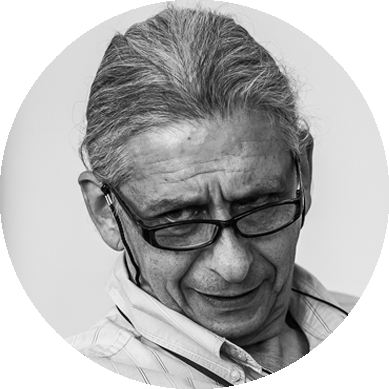
Zvi Bekerman
Zvi Bekerman teaches anthropology of education at the Seymour Fox School of Education, Hebrew University of Jerusalem, and is a faculty member at the Mandel Leadership Institute in Jerusalem. He is also an Associate Fellow at The Harry S. Truman Research Institute for The Advancement of Peace. His main interests are in the study of cultural, ethnic and national identity, including identity processes and negotiation during intercultural encounters and in formal/informal learning contexts. He is particularly interested in how concepts such as culture and identity intersect with issues of social justice, intercultural and peace education, and citizenship education.
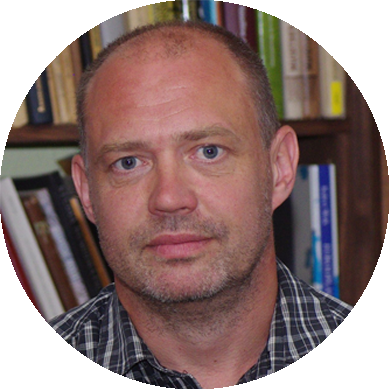
Tõnno Jonuks
Tõnno Jonuks is senior research fellow at the Estonian Literary Museum. He is an archeologist and a researcher of religion and mythology. His main research interests are related to material remains of earlier religious practices in Estonia, and in recent years his research has also been focused on a Estonian contemporary paganism movements and the discussions regarding the protection of sacred natural sites in Estonia.
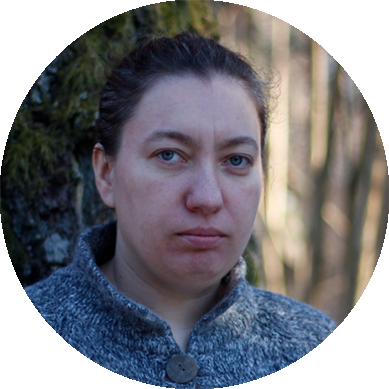
Silvia Lotman
Silvia Lotman is a biologist who has been an active practitioner in the field of nature conservation since 2004. Since 2010 she has been working as a nature conservation expert in Estonian Fund for Nature — leading charity dedicated to Estonian wildlife. Her interest is human behavioral changes that enable preserve biodiversity in its various forms and levels. Currently she is a head of species conservation program of Estonian Fund for Nature, and is leading the NaturallyEST LIFE project that aims to enhance communication and solve conflicts between local communities, nature conservation administration and different stakeholders.

Debra Ramsay
Debra Ramsay teaches film and media at Exeter University. She is the author of American Media and the Memory of World War II (Routledge, 2015), and has published articles on war, history and memory in film, television and digital games. She is currently working on a new history of warfare using media archaeology to examine the British Army’s Unit War Diaries.
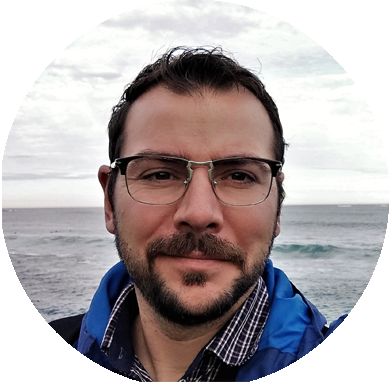
Boris Stamenić
Boris Stamenić studied journalism and Eastern European Studies in Zagreb and Berlin. He obtained his Ph.D. 2015 at the Department of History at the Humboldt University of Berlin. His dissertation «Political life of the Cavaliers game. The Sinjska alka as a vehicle of political legitimation in the 20th century» was published in the publishing house Harrassowitz in 2017. As a researcher, lecturer, and seminar facilitator in the field of non-formal education he is dealing with issues of nationalism, politics of history, and culture of remembrance in socialist and post-socialist countries of Eastern Europe.
PROGRAM
Day 1, June 5
09:00 Bus leaves from Tallinn
10:00 Bus leaves from Tartu
11:30-12:00 Arriving to Kopra, registration
12:00-12:30 Welcome coffee
12:30-13:00 Opening
13:00-14:00 Zvi Bekerman (Hebrew University of Jerusalem)
Negotiating historical narratives and identity in conflict ridden societies
I will discuss epistemological and methodological issues as these touch upon the products of educational practices related to the teaching of identity, culture, and historical narratives in educational settings created to facilitate dialogue, inclusion and recognition among children thought to belong to clearly differentiated and antagonistic groups in a conflict-ridden area – i.e. Israeli Jews and Palestinians. I offer an overview of the sociopolitical and educational contexts I have studied and vignettes of some of the events that captured my attention and led me to critically approach the present theorizing on peace and multicultural education. I finalize with reflections on the epistemological and methodological issues I encountered in my studies.
14:00-15:30 Lunch break
15:30-16:30 Debra Ramsay (University of Exeter)
Liminality and Trauma in Battlefield I
This lecture uses liminality as a conceptual framework to interrogate the merging of war and play in the first-person shooter, Battlefield I (EA Games, 2019). It examines how this videogame destabilises spatial and temporal relationships to facilitate play with memory, history and cultural meanings. We’ll challenge the notion that gameplay is incompatible with the representation of trauma (Frasca 2000) and investigate what the first-person shooter offers our understanding of war.
16:30-17:00 Coffee break
17:00-18:00 Parallel workshops
Psychologized language in education and its foundational and essentializing dangers
(Zvi Bekerman)
Generally speaking, psychologization refers to the long tradition of modern schooling to use psychological vocabularies and explanatory schemes to analyze schools, families, and individuals’ every day and institutional lives which have enabled the creation and perpetuation of a powerful regime—psychologists, counselors, educators, and other specialists—to become almost the sole decision-makers of who is going to be allowed to move up (or down) in the social ladder on the basis of powerful psychological categorizations and labels that are employed (e.g. ‘at risk’, ‘gifted’, or ‘vulnerable’ students). We will trace and discuss the sad and destructive power of the western educational metaphorization of the learner as a mind/body duality grounded in psychologized language and try to suggest some alternative paths. I will revisit the major metaphors for learning that are currently used and outline their underlying assumptions and historical development; I will then suggest two alternative paths as a response to psychologized metaphors in education. First, language therapy, that is, a vigilant critical reflection on the metaphors we use and their power to obstruct even well –meaning education reforms (multicultural and peace ed among others); and second, a turn to ontology—in line with recent efforts in various disciplines to pay better attention to the entanglement of the discursive with materiality and the body. Both of these suggestions are made in the hope of doing a better job in recognizing the destructive consequences of psychologized metaphors of learning.
Liminality and Trauma in Battlefield I (Debra Ramsay)
In the workshop, we’ll discuss the readings, gameplay in general and Battlefield I in particular, to explore the implications of the merging of play and war for the understanding of World War I, traumatic memory and for conflict as a whole. Although it does not matter if you have never played a videogame before, playing through Battlefield I would be the ideal preparation for these sessions. Alternatively, watching a walkthrough of the game would be helpful. For example: https://www.youtube.com/watch?v=t80ejGyT1Dc
19:00-20:00 Dinner
20:30 Movie evening
Day 2, June 6
09:00-10:00 Breakfast
10:00-11:00 Tõnno Jonuks (Estonian Literary Museum)
Religion, nature and nation – conflicts in Estonia in protecting sacred nature
Between 2001 and 2014 Estonia saw several public campaigns of protecting natural sacred sites. Despite the rather peaceful purpose of campaigns those actions often resulted in conflictual situations. This lecture will try to analyse the anatomy of conflict – how did the snowball start growing from the very first and almost invisible case into a massive public campaign with rock-bands, politicians and large crowds involved. My special interest is on how different groups communicated and what kind of arguments did they use to legitimise their claims, the position of history and nation in these arguments and how were academic scholars involved. But I am also interested in the broader nature of conflict itself – why is conflict good for and who keeps the conflict alive? The latter leads to the final discussion of the lecture – where did the campaign to protect sacred sites disappear after 2014 and why hasn’t it emerged again?
11:00-12:00 Boris Stamenić (Documenta – Center for Dealing with the Past, Zagreb)
Ideological turns and the political utilization of tradition
The lecture comprehends the political utilization of the local cavalier’s game Sinjska alka, performed nowadays as the annual historical festival in the Dalmatian town of Sinj (Croatia). The term political utilization refers to the processes of invention, adaption and ideological (re)interpretation of the local tradition as well as the political intentions broadcasted through it. Sinjska alka has been performed in the Dalmatian town Sinj since the 18th century as a commemoration of the military victory against the Ottomans in the battle of Sinj in 1715. Its symbolical quality of the military ceremony contributed to the remarkable continuity of the costumed festival despite several ideological turns in Dalmatia. During the last three centuries however, several other memory codes were amended to the political ritual originally established by Venetian government in Dalmatia: The birthday of the respective Emperor of Austria, the legend of the Marian apparition in the battle of Sinj, the foundation of Yugoslav kingdom (1918), the People’s Liberation War in Yugoslavia (1941-1945) as well as the Croatian War of Independence (1991-1995) have been or are currently evoked through the very same costumed competition of the horsemen. Thereby, the interpretation of the battle in the ceremonial speech have been adopted to the contemporary ideological values ever since the inception of the commemoration in the 18th Century. During the centuries of persistence of the identification of the local community with the defenders of Sinj from 1715, the interpretation of the 18th Century enemy have been far more subjected to the contemporary circumstances of the later periods. Therefore, the lecture focuses on the process of the (re)interpretation of the battle of Sinj in 1715 with special regard to the construction of historical continuity between the past and presence. The presentation is based on the hypothesis that the ideologically motivated reinterpretations of the battle, the changes of the associated ceremony, as well as the public appearances of the costumed cavaliers beyond the local festival in Sinj – commonly reflect the political history of Dalmatia. In the same time, the presentation of the empirical case offers a broader insight into the practice of political utilization of history by means of ideologically motivated reinterpretations of the local commemoration.
12:00-12:30 Coffee break
12:30-13:30 Parallel workshops
Religious, national and nature protection discourses in the context of environmental conflicts
(Tõnno Jonuks and Lona Päll)
This workshop tries to analyze situations where religion, national identity and nature protection meet and cause a conflict. The approach is preferably constructionist – instead of qualitative opinions we wish to analyse how conflicts emerge and if there are any rules how conflicts develop; what is the role of labelling and antagonism; how the broad national myths or narratives intertwine and guide the conflicts. We will provide few cases as examples to discuss and students are expected to participate in the discussion, ask critical questions and try finding connecting rules. In addition students are welcomed/expected to present similar cases from their own region in order to compare if such kind of conflicts are following universal rules or if such cases are context-depending and different in each nation/region/culture?
Analysing visual sources of the 20th century political and social conflicts in Europe
(Boris Stamenić)
Since the late 20th century, visual sources and their production have been gaining increased recognition by historians and other scholars. Static and dynamic images represent relevant objects of scientific research that enable scholars to extract valuable information and evidence.. A critical “reading” of visual sources in terms of analysis and interpretation turns into an increasingly important skill for historians and social scientists in general. However, the examination and interpretation of visual sources can be a very challenging task. Visual sources may represent unknown people settled in an unknown context or they may contain ambiguous symbols or messages whose meanings have changed over time. Furthermore, the visual sources may use humor, satire or mockery which makes the reading of the sources even more complicated. The workshop focuses on the question how to examine and interpret particular visual sources. Thereby, it provides the introduction into the analysis of visual sources based on the content, origin, motive, and interpretation of the source. The participants are going to deal with historical visual sources, with special regard to the illustrations related to the political and social conflicts in 20th century Europe.
13:30-15:00 Lunch break
15:00-16:00 Jonathan Luke Austin (Graduate Institute, Geneva)
A Portrait of the Syrian Torturer
How is torture possible? How does a human being know how to harm another? Face-to-face, body-to-body, side-by-side, scream- to-scream, blow-to-blow? These are practical questions. And to them this lecture will offer a practical guide. Unlike the relatively ‘distant’ accounts that have come before it, the discussion will draw on a series of ethnographic interviews conducted with former Syrian perpetrators of torture in order to explore how torture emerges on the ground and at an individual level in Syria. The lecture will sketch a portrait of, and trace the relationship(s) between, three ‘types’ of ‘torturer’ in Syria: ‘initiates’ (soldiers, guards, etc.) who have not tortured before, ‘professionals’ (doctors, interrogators, etc.) whose actions undergird the possibility of torture, and ‘specialists’ who have tortured in Syria for many decades. This portrait suggest that torture in Syria is frequently far less ‘intentional’ in its emergence than previously assumed and, moreover, is relatively similar in its practical, performative, and logistical format to torture carried out by other states, including democratic states. Throughout, we will reflect on what the intellectual, ethical, political, and policy implications of working towards a deep understanding of those who ‘do evil’ might mean.
16:00-17:00 Anastasiya Astapova (University of Tartu)
Anti-Immigration Conspiracy Theories and Fake News
In this lecture, we will analyze how and why immigration becomes the source of inspiration for conspiracy theories, fake news, and related genres of disinformation. We will be discussing the most recent cases from Europe, especially the Nordics and Estonia, to see how conspiracy theories and fake news on migration empower right-wing and populist agenda and to examine why they are becoming so appealing to people.
17:00-17:30 Coffee break
17:30-18:30 Parallel workshops
Savage Semiotics and Violence
(Jonathan Luke Austin)
This workshop explores the semiotics of war, political violence, and quotidian brutality. We will begin by deconstructing and displacing the typical view that the morphologies of violent conflict are hierarchically ordered from ‘above’ (by state or military leaders, etc.). On that basis, the workshop will explore how the precise form that brutal types of violence (torture, the targeting of civilians, genocide, etc.) take is dictated through processes of local semiotic ordering. These processes involve the meaning produced through cultural artifacts that seem distant from conflict (games, popular cultural rituals, etc.), group dynamics that are affectively structured, and material factors that frame the conditions of possibility for particular types of violence. To understand these factors, the workshop will introduce and discuss a range of theories, ranging from Peircean semiotics, through material-semiotic approaches, and towards Deleuzian philosophy. However, our discussions will also be continuously grounded in the micro-analysis of violent interactions, largely from across the Middle East. Ultimately, this workshop will uncover the savage potentialities of our semiotic enmeshing in the world.
Do You Think They Can Stay? The Role of the Right Narrative in the Asylum Cases (Anastasiya Astapova)
In the workshop, we will discuss the procedure of the application for asylum status in Europe and the USA to see how the legal norms shape the strategies of asylum-seekers and how the latter learn to navigate legal demands for the asylum application. In particular, we will dwell on the role of the right narrative of persecution which must comply with certain rules to create the image of bona fide refugee that would appeal to those who make the decision. Based on the fieldwork examples recorded in the Estonian accommodation center for asylum seekers, we will analyze several cases of asylum applications to see how and why they succeeded or failed. Finally, we will discuss how legal demands for the flawless narrative shape the behavior of the asylum-seekers when they wait for their cases to be proceeded.
19:00-20:00 Dinner
20:30 Nature walk with Silvia Lotman
Day 3, June 7
08:00-09:00 Breakfast
09:00-10:00 Silvia Lotman (Estonian Fund for Nature)
Conflicts in Nature Conservation
The lecture will give insight into the conflicts that emerge from natural resource management and conservation, conceptualise environmental peacebuilding as a theoretical framework and complement theory with practical examples from the field of nature conservation.
10:00-10:15 Coffee break
10:15-11:35 Student presentations (15+5 minutes)
“Concept of emancipation in Ivar Puura’s conceptual framework of semiocide”
In his essay, «Nature in Our Memory» (2002 [2013]: 152) Estonian geologist Ivar Puura coins the term «semiocide», which he defines as «signs and stories that are significant for someone are destroyed because of someone else’s malevolence or carelessness, thereby stealing a part of the former’s identity.» According to Puura, semiocide has two modes of occurrence -accidental and malevolent. The accidental mode generally stands for the situation where the adverse effects of destruction occur through the ignorance and lack of direct intent of the agent(s) involved, whereas malevolence, whereby the actor consciously intends to destroy or at least severely cripple a target sign system. Malevolent semiocide demonstrates itself in various and wide-ranging array of human activities from war and aggression to more subtle if not less violent means of domination of nature and society.
This presentation attempts to broaden this typology to include emancipation in the framework, in order to elucidate acts of liberation from oppressive and punitive systems, employing means that efface the oppressors semiotics arsenal.
“Foreign language insertions as a manifestation of verbal aggression in the internet discourse of Russian speakers living in Estonia”
In present-day society in the most different spheres of communication, we can notice an increasing escalation of rudeness and hostility. This kind of speech behaviour can be defined as verbal aggression which is realized during the interaction between the members of the linguocultural society. Verbal aggression is an integral part of the sociocultural cognitive matrix, a model of interconnection and interrelation (Larinova 2017: 199). It performs an orienting function in the community, emphasizing the opposition “us” vs. “them” (ibid.). In linguistics, however, there are different understandings of the term verbal aggression, which is explained by the variety of this behaviour (Sedov 2005: 88). Verbal aggression has different faces, sometimes it disguises as politeness. In this paper I consider verbal aggression as a communicative action which has the purpose of causing in the interlocutor a negative emotional and psychological state (fear, frustration, etc.) (Sedov 2005: 88). Internet has features, primarily anonymity, that intensify this phenomenon. Verbal aggression can also be observed in the internet-communication of Russian speakers living in Estonia, where very often Estonian words are used in aggressive contexts, as in (1). Cases of insertions from Estonian are marked with square parenthesis: (1)[Eestlased! Peab midagi tegema.] Ty adresom ne oshibsya, lyubeznyi? [Ээстласед] — eto na toi polovine, a zdes’ [тиблад, венкуд, вандид, сибулад, умбкеэльсед окупандид]. [Estonians, we must do something]: Are you talking to the right people, my dear? [Estonians] – are on the other side, here there are [*several rude and offensive words used in Estonian to indicate Russians*]. The purpose of my paper is to (i) to analyse the presence of Estonian words in the different forms of verbal aggression in the internet discourse of Russian speakers living in Estonia, (ii) to demonstrate how verbal aggression intersects with the opposition “us” vs. “them”. The material analysed in this paper has been collected from forums and Facebook groups.
“An Other Space — Heterotopia and Memory at Levashovo Wasteland”
Michel Foucault’s notion of heterotopia — “an other place”, for short — spawned a vast amount of literature on various “other” spaces, real and imaginary. In my presentation, I plan to apply this notion to discuss a case of a mass grave on the outskirts of St. Petersburg — Levashovo Memorial Cemetery (known also as Levashovo Wasteland), a place, where victims of Soviet repressions were buried in secrecy. In 1989, it was officially opened to the public and spontaneous commemoration of the dead has begun, which resulted in installation of several monuments. The presentation will be focused on “otherness” of this place (particularly in comparison with other memorial sites), which serves to expose the (semiotic) conflicts between historical narratives, existing in the contemporary Russian society.
“The bad or good in brands is all about meaning”
Every brand that is produced by a company or organisation involves conflict on different levels. Mainly there cannot be a brand without conflict. In every level of a brand, there is a conflict between consumer or client and brand itself, because through the conflict product/service will be communicated to the target audience. Bad or good in brands are all about everything else than the meaning of storytelling. Conflicted brands are a problem of meaning-making and how people interpret objects that are communicated, for example, posters, videos and texts.
I will show, how conflicts in brands storytelling are essential and necessary, but if the conflict is in the communicated meaning, then the whole brand suffers economically and socially.
For example, Pepsi Caitlyn Jenner commercial is not acceptable, because it manipulates communicated the meaning of war in real life. The commercial as itself made a good story. Without real-life implication, the commercial would not be unacceptable; then it would be just ad about justice.
Stronger example of my view of conflicts in brands will be music videos as brands their own. Music videos would be good or bad through target audience view to the music video. That means the same type of music videos can be differently understood by the global target audience and judged to the right or lousy brand.
For example, “Hate” by 4minutes and “Me!” by Taylor Swift is the same type of songs about individualistic values. Western viewers praise both music videos, but not so much by eastern viewers. A known fact is that “Hate” by 4minutes, is restricted K-pop song, because of individualistic song value. I can predict that “ME!” by Taylor Swift is in eastern countries negatively interpreted because it goes in the opposite value direction.
11:45-12:00 Coffee break
12:00-13:20 Student presentations
“The impact of dangerous speech: the case of alt-right content creators on Youtube”
On March 15, 2019, a gunman killed 50 people in a mosque in Christchurch, New Zealand. As in a range of other similar attacks, the terrorist was reported to be a supporter of alt-right, a movement closely associated with a network of popular white nationalist personas on YouTube. We argue that the content produced by right-wing influencers serves as radicalizing factor for mass shootings committed in the name of white supremacy. We restrict our analysis to the content created by the members of Alternative Influence Network (AIN). As 2018 Data & Society Research Institute report “Alternative Influence: Broadcasting the Reactionary Right on YouTube” suggests, the AIN is a widespread network of social media celebrities and public figures that use YouTube as a platform to built influence by transmitting political content characterized as ranging from common conservative or libertarian to white nationalistic. To analyze the AIN content, we use the integrated model of dangerous speech and dangerous ideology, proposed by Maynard and Benesh as a more comprehensive way to monitor and prevent speech which can cause violence and atrocities. The use of the dangerous speech model would allow to better understand the serious impact of the alt-right network influence on people who can be lead to inflict violence. Furthermore, while the most prevalent acts of violence can be seen in context of the dangerous speech generated by the alt-right content creators and influencers, one can also take in account the large amounts of harassment and intimidation both in online environments as well as in real life, which can be directly linked to the way how the AIN members interact with their audience. We show that the broadcasts of AIN members correspond to the definition of dangerous speech, and in conditions necessary for escalation can have similar effects as triggers of mass violence.
“Modal semiotics”
Sciences dealing with culture readily admit the plurality of cultures. Plurality affords differences in types of thinking as well as in cultural traditions. Conflicts between individuals or cultures (irrespective of their ‘volume’) may be postulated to be caused by misunderstandings, disagreements and arguments between participants, and conflicts also tend to become protracted either in time (docile hostility) or space (active hostility, war) until they are resolved. On the basis of the plurality of cultural universes, it is presumed that conflicts may sprout wherever there is a clash of two (or more) types of thinking which are not reconcilable. In such cases they also remain unexplainable by means of traditional semiotics due to unbreachable differences in modalities of thinking.
The aim of this presentation is to introduce a different methodological approach to cultural traditions and types of thinking, namely, that of modal semiotics as articulated by Zilberman (1988). Instead of the more conformist semiotic analysis – the study or construction of significational models (of culture) as though they were actual objects – modal semiotics provides us with a three-dimensional understanding of what culture is. Whereas semiotics deals with signs and sign systems, “[The] central premise of modal methodology is that any fixable modal relation may be denoted by symbols but that in no case should it be understood as a sign of something” (Zilberman 1988: 307 [emphasis original]). That is, traditional semiotics takes the elements of the tri-partite sign to be existent in the real or ideal sense, but this is dispensable in modal semiotics which allows for the separate treatment of significance, signification and meaning. By identifying three levels of modal reality – absolute reality, level of phenomenation, absolute irreality – and three modalities therein – apodictic, deontic, hypothetic – we are well under way towards a better understanding of thinking and by extension culture as such.
“Conflict in acceleration society. Conflict as an instrument for controlling temporality in the modern accelerated society”
Conflict can be seen as an instrument for changing or manipulating time-relations within a society. This view hints that conflict takes time to be constructed and takes time to resolve. Moreover, occupying time could be regarded as part of the goal which the conflict itself has, which may lead to a type of stagnation in the form of lasting conflict. More precisely, conflict can keep a society within its own pace with the aid of modern media. The idea of controlling temporal relations via conflict can be theorized further with the aid of temporal analysis by distinction of symbolic (continual time) and discrete time, which builds on the notion of change. This means that conflict has a concrete effect on time understood as discrete: conflict produces fertile semiotic circumstances for change, which has an effect on semiotic time-space of the society (i.e. digital communicative spaces etc, which fill themselves with content of the conflict). For example, a media scandal around politics can freeze the society to a certain momentum. Analysis of manipulation of time by conflict is perhaps even more critical in the circumstances of social acceleration: modern communication media is capable of overflowing communication with interactions, thus distorting evaluation and critical insight within the society. Consequently, modern accelerated processes can exceed the pace of democratic processes, leaving room for confusion and populism built upon it, which can be done by conflict.
“Human-AI conflict in sci-fi narratives”
In a typical pop culture narrative starring an artificial creature of intelligence, the robot is often depicted as a ‘perfect human’ (or, in Lotman’s terms, a perfect work of art), while the ‘real’ humans are seen as weak, helpless, and at the mercy of robotic creatures that are manipulating the situation at will. The ultimate fate of mankind is left to the reckoning between the “benevolent” and “evil” AI, thus stripping humans of their agency. Even the secretly powerful technologists (or scientists in Haynes’ terms) are shown to lose control of their creations — a kind of fabula that in AI-related public discourse can also be recognised as technification in the terms of Hansen & Nissenbaum (2009).
Vincent Mosco (2004) points out myths as valuable tools for understanding complex things such as technology. Roslynn Haynes (2014) discusses literary narratives featuring stereotypical scientists whose experiments get out of control and bring humanity to peril.
In the presentation I will briefly describe a few examples of such popular narratives in the cinema, observe how they can be related to the frameworks of Mosco and Haynes, and see what the concept of artificial intelligence offered by Tartu-Moscow School could bring to the mix.
13:30-14:15 Lunch break
14:15-15:00 Coffee and final discussion
15:15 Departure to Tallinn and Tartu
Spring school Photos
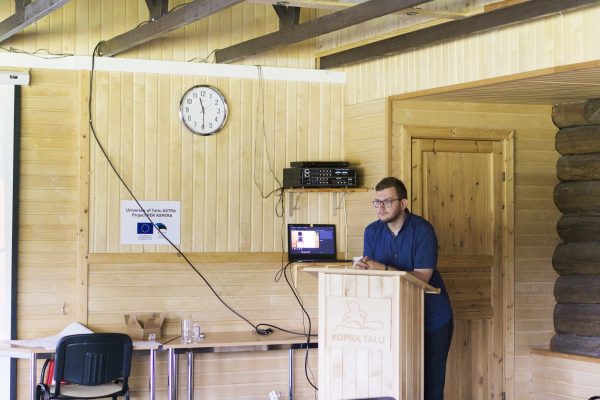
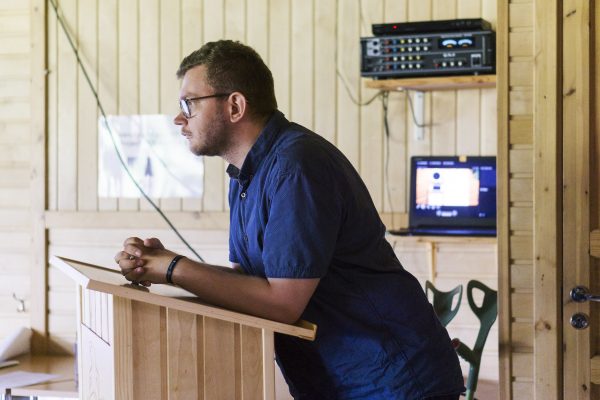
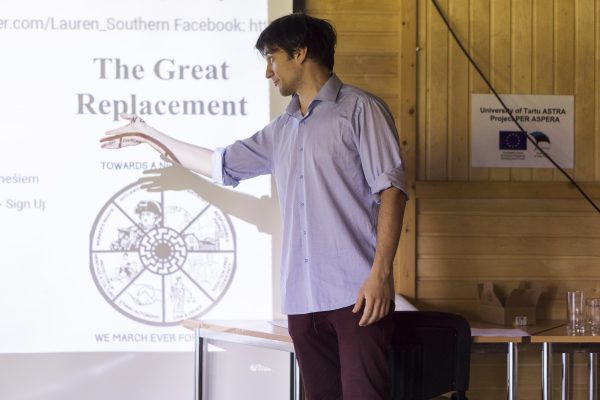
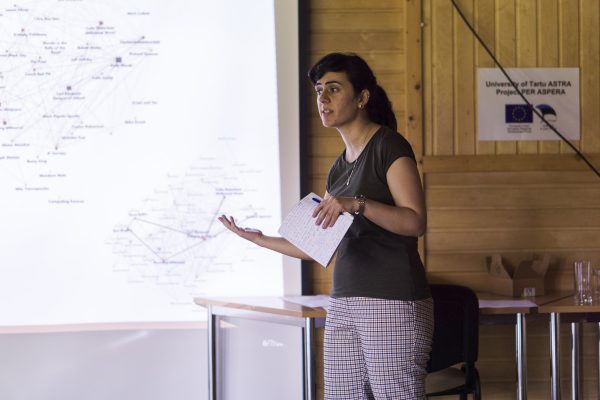
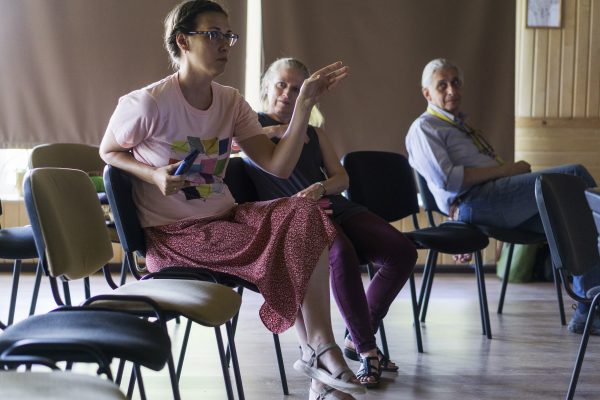
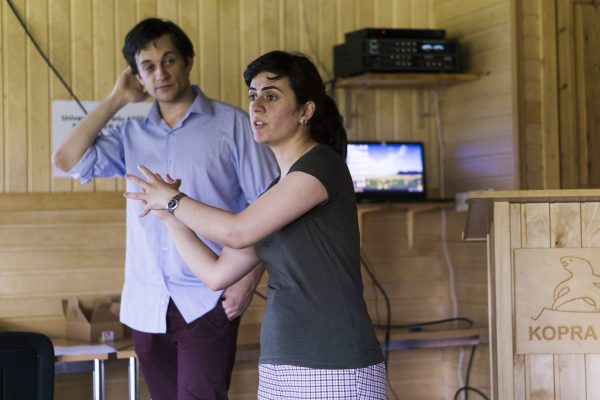
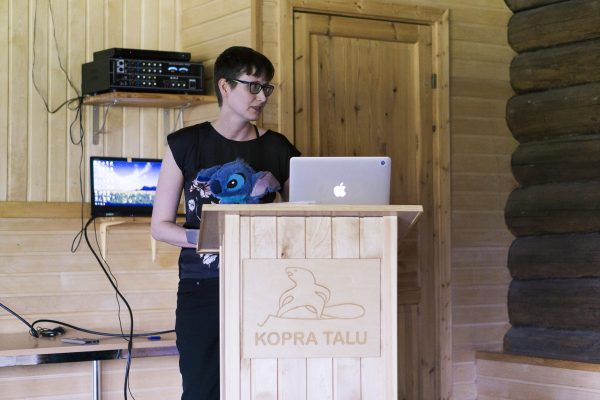
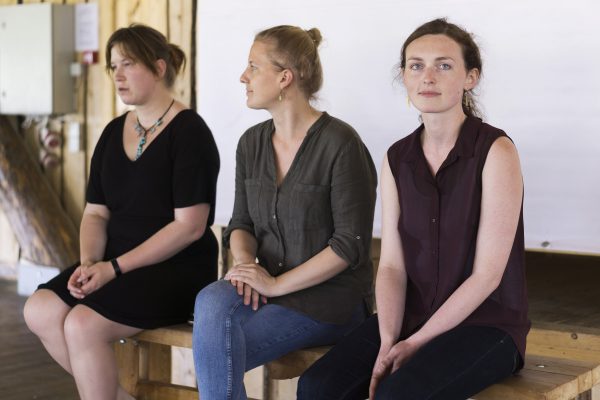
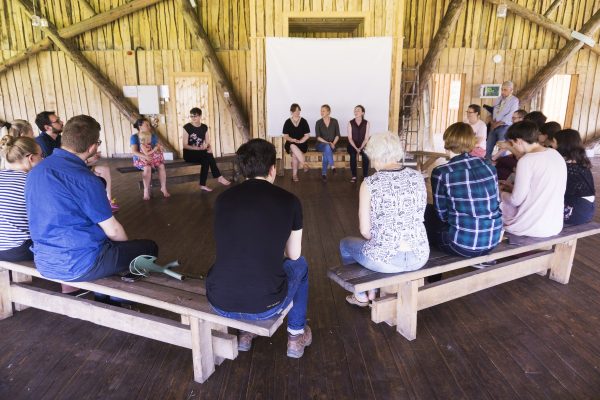

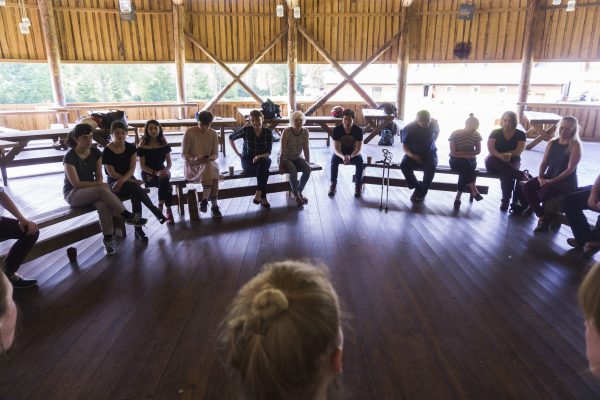
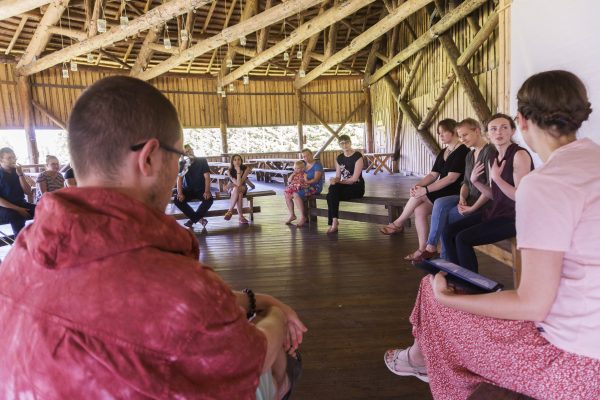
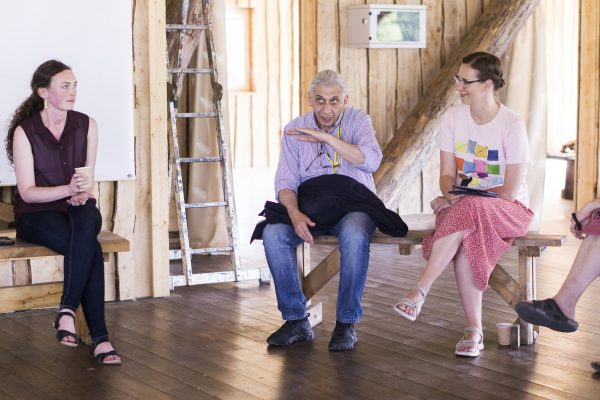
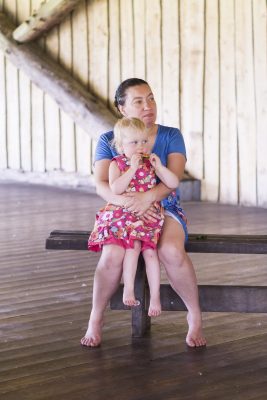
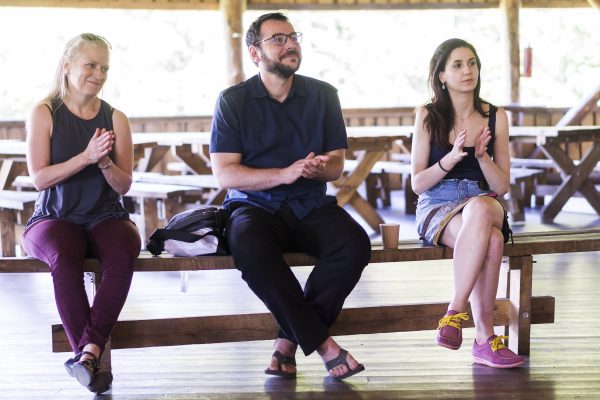
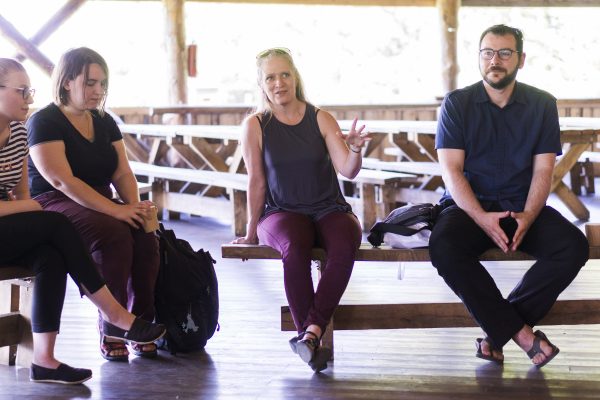
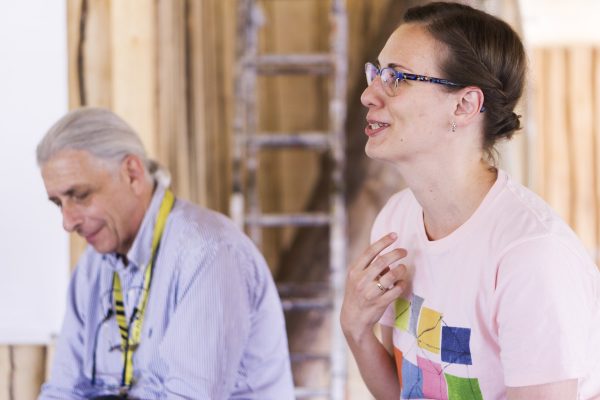
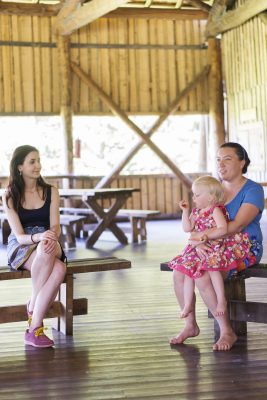

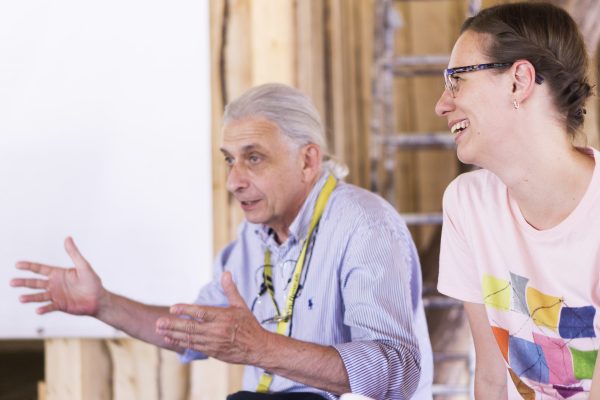
ORGANIZERS
The organization of the event has been supported by the Department of Semiotics at the University of Tartu in cooperation with the Graduate School of Culture Studies and Arts. The Spring School is financed by the European Regional Development Fund (University of Tartu ASTRA Project PER ASPERA) and PUT1363.
